Abstract
This review conducts a bibliometric analysis of scientific literature on antibiotic resistance in Helicobacter pylori (H. Pylori), aiming to map scientific production, identify trends and key themes, analyze collaboration models, and highlight research gaps to inform research priorities and guide public health policies, amidst the growing challenge of multidrug resistance affecting treatment success. Background/Objectives: H. Pylori infection is usually contracted during childhood and often becomes chronic and asymptomatic in 80–90% of cases. Eradication requires complex treatments involving proton pump inhibitors and multiple antibiotics, but success rates have declined due to increased antibiotic resistance caused by genetic mutations, efflux mechanisms, altered membrane permeability, and biofilm formation. Reports indicate an alarming increase in multidrug resistance, affecting the effectiveness of treatments. Methods: The bibliometric analysis was performed using the Web of Science Core Collection (WoS) database, which provides comprehensive bibliographic data. Filters were applied for articles in English, reducing the set to 39,879 papers. The analysis was performed using the VOSviewer program (v1.6.20) to visualize co-author networks, citations, and keyword co-occurrence, and Microsoft Excel for processing and organization. Results: Editorial Trends: Over the last decade (2016–2025), interest in this topic has increased, with over 4000 publications annually in 2020, although a slight decline was observed in 2023. Leading Contributors: China is the most prolific author, followed by the USA and Japan. Cited Articles and Key Publications: Articles by prominent authors are frequently cited in 2022 and 2023, indicating their high relevance. Bibliographic Coupling Analysis: This revealed three main thematic clusters centered around research by specific authors. Keyword Analysis: A total of 57,462 terms were identified, of which 5292 appeared at least five times; “Helicobacter pylori” was the most frequent, followed by “infection” and “eradication.” Visualized terms highlight central areas of interest, such as “risk,” “cancer,” and “resistance”. Conclusions: This bibliometric analysis underscores a rising research focus on H. pylori antibiotic resistance, with recent publications providing essential clinical guidelines and epidemiological insights into the infection’s global impact. China leads in contributions, followed by the US and Japan. Significant articles by notable authors received many citations, emphasizing their significance.
1. Introduction
Helicobacter pylori (H. Pylori) is a Gram-negative, spiral-shaped, microaerophilic bacterium specifically adapted to infect humans [1]. It represents one of the most common infectious agents worldwide, being implicated in the pathogenesis of chronic gastritis, gastric and duodenal ulcers, as well as severe forms of gastric cancer [1,2] and mucosa-associated lymphoid tissue lymphoma [3]. According to a systematic review and meta-analysis by Zamani et al., over 44% of the world’s population is infected with H. pylori, including more than half of the inhabitants of developing countries and nearly a third in developed countries.
H. pylori infection is usually acquired in childhood and becomes chronic if not eradicated, remaining asymptomatic in the majority of cases (80–90%) [4], being able to colonize almost half of the world’s population [5].
It is a class I carcinogen, closely associated with severe gastric diseases, and can induce immune tolerance in the host, facilitating its colonization and persistence in the gastric mucosa. The gastric epithelium, through Toll-like receptors (TLRs), plays a crucial role in recognition and initial immune response, but the exact mechanisms of TLR-mediated tolerance induction are not fully understood. Research has shown that, both in vitro and in vivo, prolonged exposure to H. pylori leads to an initial increase in TLR6 and inflammatory cytokines, followed by a decrease in these, suggesting a mechanism of immune adaptation [6].
H. pylori adapts and maintains a long-lasting balance with its human host, demonstrating a remarkable ability to manipulate the immune system. It also possesses sophisticated strategies, such as biofilm formation [7] and entering a dormant state, which allow it to persist and establish long-term chronic infections, even under stressful conditions. H. pylori can adopt three main morphological forms—S (spiral), U/C (transitional forms with low enzymatic and metabolic activity), and coccoid—and the presence and proportion of these forms in the mucosa or culture varies depending on the duration of exposure to adverse conditions and the intensity of stress factors, highlighting the adaptability and complexity of this pathogen in the gastric environment [8].
The coccoid form is characterized by a different wall structure, which reduces its recognition by the immune system and makes it 10 times more resistant to amoxicillin than the spiral forms. Although it has low activity and reduced metabolism, the bacteria retain their infectious capacity and virulence factors, supporting the development of chronic diseases and resistance to treatment [5,8,9].
H. pylori adopts a dormant state to survive under certain conditions (low temperatures, lack of nutrients, or antibiotics), making it difficult to detect using conventional methods [10]. There are two main forms: the viable but non-culturable state and the antibiotic-persistent state. The first form, which occurs in response to stress, does not regenerate quickly after the cause is removed, while the second form, antibiotic persistence, regenerates after a delay [9,11].
The existing data on the viability of coccoid, U, and C forms of H. pylori are contradictory. Although some studies consider that transformation into coccoid forms indicates functional disintegration, other evidence shows that these forms retain their cellular structure and respiratory activity and can revert to the vegetative form. In addition, the coccoid form may be viable and capable of active infection, expressing virulence genes and contributing to chronic disease. Thus, coccoid forms are not necessarily inert, but may play a significant role in pathogenesis [8].
Eradication treatment involves complex therapeutic regimens, generally combining a proton pump inhibitor (PPI), widely used, or newer agents (vonoprazan or bismuth) to increase gastric pH, with two or three antibacterial agents, such as amoxicillin, clarithromycin, metronidazole, tetracycline, or levofloxacin, sometimes in association with bismuth compounds [12]. However, treatment success has progressively declined in recent years, largely attributable to the increasing bacterial resistance to antibiotics. Resistance in H. pylori results from chromosomal genetic mutations, efflux mechanisms, alterations in membrane permeability, and biofilm formation, all of which contribute to treatment failure. Recently, reports have highlighted an alarming increase in multidrug resistance worldwide [13].
Although research in this area has grown significantly in recent years alongside technological advances, a coherent and well-structured understanding of the evolution of scientific literature—particularly in clinical management and outcome assessment—remains underdeveloped. Bibliometric analyses are essential tools in scientific research, with a major impact on promoting and consolidating knowledge; it is responsible for organizing, classifying, and evaluating scientific publications at various levels [14]. They allow for an objective evaluation of the state of research in a given field, providing a clear picture of its trajectory and scholarly dynamics. One of the key advantages of bibliometric analysis is its ability to identify critical research gaps. By examining publication volume, citations, and trends, researchers can discover unexplored subdomains or research questions, thereby directing efforts toward areas with potential for innovation and development.
Additionally, bibliometric studies help define future research directions, identify emerging trends and growing domains, and facilitate strategic planning of scientific projects. They also map authors, institutions, collaborations, and journals with significant impact. Identifying leaders in the field, collaboration networks, and the most influential publications allows researchers and institutions to establish strategic partnerships, choose the best venues for disseminating results, and monitor evolving trends. This process increases scientific visibility and recognition, fostering a more competitive and innovation-driven research environment. Therefore, bibliometric analysis serves as a cornerstone in evaluating and guiding scientific research, deepening comprehension of the field’s current landscape, supporting scientific advancement, and assisting evidence-based decision-making.
This review aimed to conduct a bibliometric analysis of the scientific literature on antibiotic resistance in H. pylori, with the objectives of mapping scientific production, identifying trends, key themes, collaboration models, and research gaps, in order to inform research priorities and guide public health policies.
2. Results
2.1. Literature Overview
Evaluation of publication trends over the last decade (2016–August 2025) indicates a growing interest in the subject. Between 2016 and 2020, publications numbered under 4000 per year, showing a gradual upward trajectory. Since 2020, annual publications exceeded 4000, following an upward trend, with a slight decline in 2023 (Figure 1).
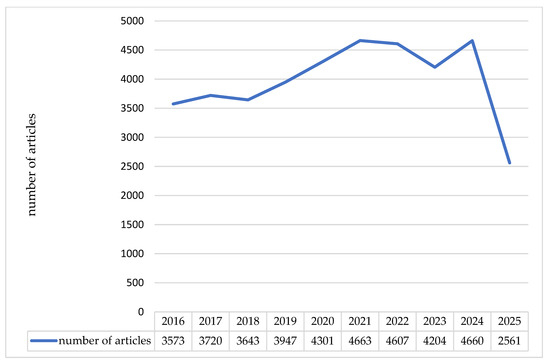
Figure 1.
Temporal distribution of scientific publications.
The vast majority of articles were published in English (38,964 articles, Figure 2).
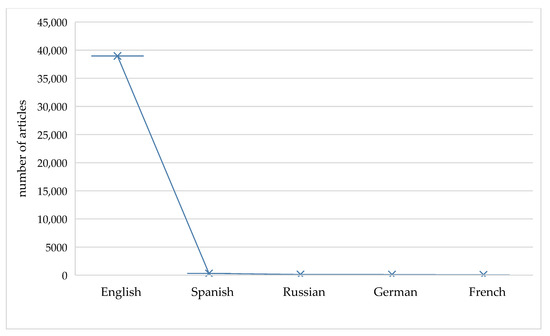
Figure 2.
Publication language of articles.
The top 10 subject areas are summarized in Figure 3. Approximately 30% of articles fall into Microbiology, Gastroenterology And Hepatology, and Pharmacology And Pharmacy.
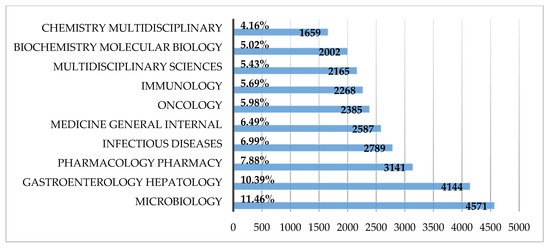
Figure 3.
Subject areas of publication.
The top 10 most productive countries are shown in Figure 4. China ranks first, followed closely by the USA. Japan holds third place, with roughly one-quarter of the publication output of the leading two countries.
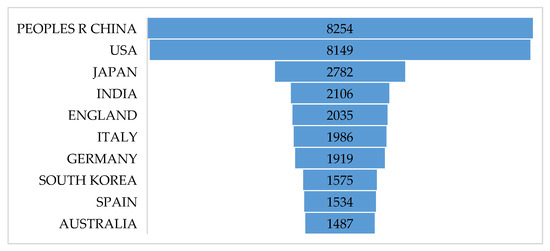
Figure 4.
Top 10 most productive countries publishing on H. pylori antibiotic resistance.
2.2. Document Citation Analysis
Table 1 lists the top 10 most cited articles. Notably, Malfertheiner authored two highly cited articles in 2022 and 2023 (681 and 464 citations, respectively), indicating strong influence.

Table 1.
Top 10 most cited articles.
Figure 5 shows the most cited articles.
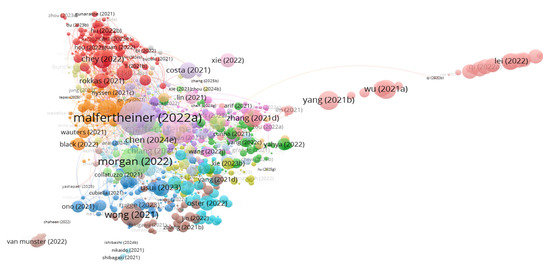
Figure 5.
Map of most cited articles (VOSviewer).
The “bibliographic coupling” relationship between documents is a method of analyzing the connections between scientific papers based on their common references. Essentially, two documents are considered bibliographically coupled if they cite the same set of sources or have common references. The bibliographic coupling relationship in VOSviewer provides an analysis of the conceptualization, influence, and thematic relationships between documents, based on common references. This provides insight into the structure and evolution of a research field, which is useful for identifying thematic clusters and main research topics in a given body of literature. Three clusters were identified (Figure 6). The red cluster consists of 452 articles and has Chen at its center, while the blue cluster includes two of Malfertheiner’s most cited articles; however, it contains the smallest number of articles (n = 195).
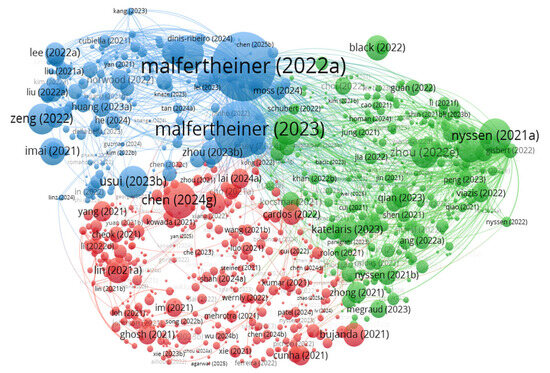
Figure 6.
Bibliographic coupling map.
2.3. Top Cited Authors
Of 107,346 identified authors, 2209 had at least five articles. Table 2 summarizes the top 10 authors by publication volume. Analysis of the data in Table 2 suggests that, in terms of productivity (number of articles published), first place is occupied by P. Malfertheiner (n = 29), followed by F. Megraund (n = 27), J.P. Gisbert (n = 21), S. Seurbaum (n = 16), C. Schulz, and M.C. Camargo (n= 19). The most citations are associated with the publications of Malfertheiner (n = 1877), Megraund (n = 1785), and Liou (n = 1463). Based on the average citations per document, the authors are ranked as follows: A. Gasbarrini (n = 119.22) and J.-M. Liou (n = 112.53). In terms of network connectivity (TLS), the highest value is held by F. Megraund (n = 2645), followed by P. Malfertheiner (n = 2505) and Liou (n = 1958).

Table 2.
Top 10 authors by citations.
In the co-citation network (right side), the strongest connection belongs to P. Malfertheiner (TLS = 48,447), followed by D. Y. Graham, J.P. Gibert, etc., indicating a central network in which these authors are frequently cited together in papers.
Authors who are frequently cited, with high co-citations, can be considered influential or reference authors in the field. If two authors have high co-citations, it means that they are often cited together in the same documents. This may indicate that their research is complementary or contributes to the same subfield. In the visualization, these authors appear as being in the same cluster.
Authors with high co-citations but fewer citations may indicate collaborations between researchers or research groups working together. Of the total of 360,545 authors, 5168 authors have a sufficient level of citations and co-citations to be included in the network analysis, being grouped into 9 clusters. Their co-citation relationship reflects the connections and collaborative structure in the field, being an important indicator for identifying clusters and influence in research (Figure 7).
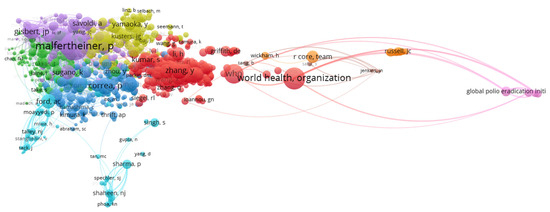
Figure 7.
Co-citation network of leading authors.
2.4. Keyword Analysis
As for keywords, 57,462 words were identified; of these, 5292 were encountered at least five times. The most frequent keyword was “helicobacter pylori,” followed by “infection” and “eradication.” The map reflecting the frequency of occurrence of keywords is shown in Figure 8.
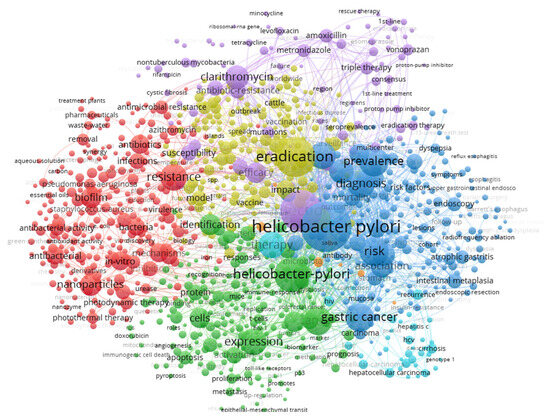
Figure 8.
Keyword co-occurrence analysis by research themes, processed with VOSviewer.
The size of the nodes in the network highlights the relevance of the keywords, with larger nodes and more connections indicating a greater interest in the subject studied. Also, the distance between nodes reflects the frequency of their association in the same document. Terms close to the center of the image (Helicobacter pylori), such as “eradication,” “risk,” “cancer,” and “resistance,” form an additional area of interest.
2.5. Scientific Mapping
The network of collaboration between countries (Figure 9) provides important evidence of the significance of the topic. Setting a minimum threshold of five documents for inclusion resulted in the formation of a network of 139 countries, organized into 10 distinct collaboration clusters, highlighting both traditional and emerging partnerships.
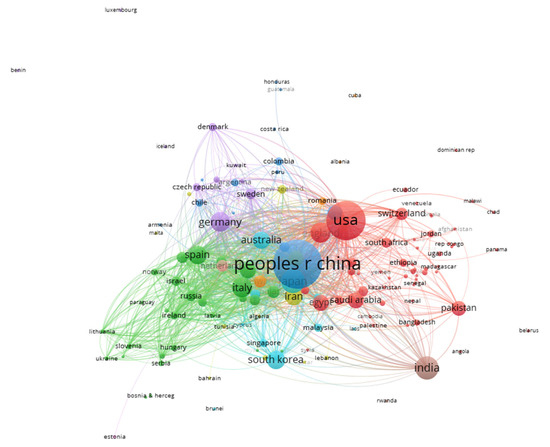
Figure 9.
International scientific collaboration network.
The cluster to which the United States belongs (red) consists of 56 countries, followed in importance by the cluster (green) consisting of 27 countries (including Spain, Italy, Poland, France, Greece, Portugal, Slovenia, etc.)—regional centers marked by active intra-European collaboration. This group shows strong internal cohesion, reflecting sustainable research partnerships supported by the European Union. Russia, Israel, Turkey, and Ukraine are also part of this hub, demonstrating transcontinental collaboration.
The third important hub (blue), consisting of 13 countries, includes the most important contributor, namely the People’s Republic of China, which plays an essential role in interconnecting the scientific community.
2.6. Distribution by Journals
Journals with a high volume of articles and citations, such as SCIENTIFIC REPORTS and HELICOBACTER, are more productive and have high TLS, indicating strong network connectivity (Table 3). The highest TLS values are associated with HELICOBACTER (593,177), SCIENTIFIC REPORTS (544,086), CUREUS (535,809), and PLOS ONE (462,524), indicating strong network connectivity. FRONTIERS IN IMMUNOLOGY and ANTIBIOTICS-BASEL have the highest average citation values per article (8.56 and 8.47, respectively).

Table 3.
Top 10 journals by publications and citations.
Figure 10 illustrates the temporal map of the most cited journals, with the yellow color suggesting the most recent citations.
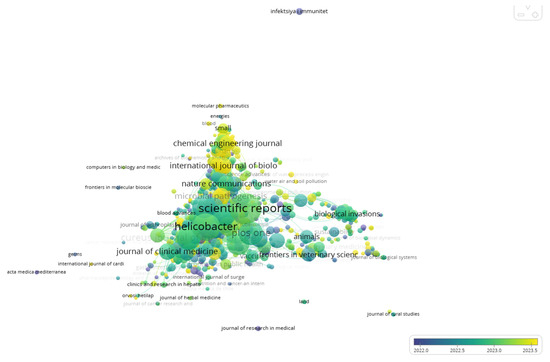
Figure 10.
Temporal map of top-cited journals.
3. Discussion
This bibliometric analysis suggests increased interest among specialists in the field in the antibiotic resistance of H. pylori, similar to other analyses of this type [25,26,27], likely explained by the increasing prevalence of drug resistance over the last decade, particularly among individuals who have previously been treated for eradication [28]. In the analysis published in 2023 by Meng Li et al. for the period 2002–2022, the number of articles identified is significantly lower than in our bibliometric analysis for the period 2016–2025 (3817 versus 39,879) using the same database (WoS). The most cited articles are those by P. Malfertheiner (2022 and 2023, respectively) [15,16], which is to be expected, given that the first is a guide to therapeutic management. The articles published in 2012 and 2017 by the same author also rank first in terms of co-citations in another bibliometric analysis (2023) [29]. In the same analysis by Meng Li et Al., two other articles by the same author occupy second and third place. The results of the bibliometric analysis conducted between 1983 and 2020 suggest a sudden increase in the number of publications from China [30]. The conclusions suggested by Y. Fang et al. highlight the need to understand the genetic and phenotypic characteristics of H. pylori in Zhejiang, China, in order to analyze antimicrobial resistance and virulence, to support the development of more effective treatment and control strategies [31]. China and the USA occupy the top places and retain their leading positions in terms of publication volume, similar results being published by other authors [25,29,32]. Contrary to other studies, the findings published by R. Wang (2023), analyzing publications from 2002 to 2021, rank the United States as the most productive and influential country [26].
The first place in the top 10 journals with the most publications on the researched topic is occupied by SCIENTIFIC REPORT (n = 354), followed by HELICOBACTER (n = 287) in our analysis; in the previous analysis, it ranked first with 261 articles [32]. PLOS ONE remains a key journal, both in terms of the number of publications and the number of citations [27].
Graham DY (USA) remains one of the most influential authors, similar to the bibliometric analysis carried out for 2012–2022 by C. Yu et al. [25,29]. The GUT magazine with the most citations in the same period (2012–2022) comes fourth in our analysis [25].
The keyword analysis of the bibliometric analysis of research on H. pylori resistance between 2002 and 2022 identified four main areas of research: therapeutic strategies, diseases, mechanisms and epidemiology, and drug research, with a notable emphasis on the selection and analysis of treatment strategies [32]. Keywords show increased variability. The keywords in our analysis (“eradication,” “risk,” “cancer,” and “resistance”) were different from those identified by other analyses (“oxidative stress,” “probiotics,” “competitive acid blocker,” “vonoprazan,” “gut microbiota,” and “neutrophil-activating protein”) [25], respectively—“Clarithromycin resistance”, “prevalence”, “gastric cancer”, “quadruple therapy”, “sequencing therapy”, “23S rRNA”, “whole genome sequencing”, “bismuth” and “probiotics” [29]. The bibliometric analysis, published in 2025 by S. Farina et Al., highlights the central role of key concepts such as “knowledge,” “attitudes,” and “management” in educational initiatives to combat antimicrobial resistance [27].
Articles can be categorized into several themes (guidelines/consensus, epidemiology, cancer risks, etc.) with implications for clinical practice (Figure 11). The essential articles provide the theoretical basis, clinical guidelines, and critical epidemiological data for understanding and controlling H. pylori infection, which are indispensable for guiding treatment and prevention strategies. Articles published by Malfertheiner (2022a) [15] and Chiang (2021) [23] provide standardized recommendations and clinical guidelines, which are fundamental to medical practice. Articles providing data on epidemiology, global incidence/mortality {(Morgan (2022) [17], Wong (2021) [19], and Chen (2024e) [22]} and the role of H. pylori in the etiology and risk of gastric cancer Yang (2021b) [21] can also be considered essential articles.
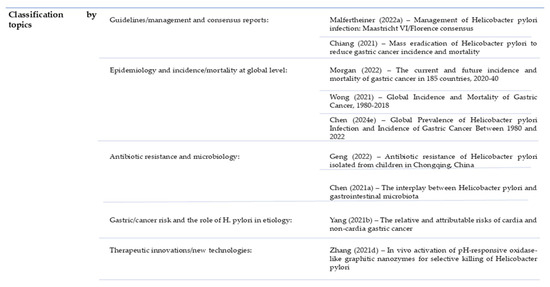
Figure 11.
Publication thematic classification [15,17,18,19,20,21,22,23,24].
In contrast, complementary articles add detailed information about the microbiology of the bacterium, resistance to treatment [Geng (2022) [18], Chen (2021) [20]] and technological innovation Zhang (2021d) [24], and are valuable for further study and advanced research, but not fundamental to current practice guidelines.
P. Malfertheiner, in the Maastricht VI/Florence Consensus Report [15] from 2022, supports the need to initiate antibacterial treatment in all patients who test positive. This report was contributed to by 41 experts from 29 countries who analyzed indications/associations, diagnosis, treatment, prevention, the risk of gastric cancer and H. pylori, and the intestinal microbiota. The recommendations are based on the best available evidence and their relevance to the management of infection in various clinical contexts.
H. pylori chronically infects the gastric mucosa, with a clinical spectrum ranging from asymptomatic infection to peptic ulcers and gastric cancer [33]. H. pylori DNA is detectable in various ecological niches (oral cavity, water sources), but active colonization has only been demonstrated in the stomach (stomach, areas of gastric metaplasia in the duodenum). H. pylori infection predates the migration of Homo sapiens from Africa. The genetic diversity of the bacterium reflects the geographical origin of the host [34].
The high mutation rate is already well known; natural competence generates massive inter-strain genetic variation, superior to that of other human pathogens. This genomic plasticity favors rapid adaptation to changing conditions in the gastric environment; however, diversity is partially maintained by recurrent bottlenecks. The evolution of H. pylori’s lifestyle represents an evolutionary race to maintain an adequate pool of genetic variation capable of resisting selection [4]. Epigenetics is an important determinant of H. pylori plasticity, facilitating rapid adaptation and possibly phenotypic variation between strains. To fully understand its impact, it is necessary to characterize methylases, map the methylome at the strain level, and study the links between methylation and gene expression, with implications for virulence, diagnosis, and therapies. Helicobacter pylori is capable of taking up genetic material from the environment through natural transformation and integrating DNA into its genome. The stomach is the climatic niche in which it lives, and mixed infections with unrelated strains facilitate extensive exchanges of genetic material, leading to rapid genetic diversification [4].
Given the broad clinical spectrum of associated gastritis, regular updates are needed for optimal management, covering clinical scenarios, appropriate testing, and strategies for preventing gastric cancer and other complications [15].
Challenges related to treatment and eradication are linked to increasing antibiotic resistance [33] and the need for sensitivity testing, taking into account new molecular technologies and the selection of first-line and rescue therapies, as well as the impact on the microbiota [15]. Helicobacter pylori resistance in Chinese children is associated with specific mutations: A2143G in 23S rRNA (clarithromycin), G47A in rdxA (metronidazole), and mutation at position 91 of gyrA (levofloxacin). Sensitivity testing and genetic screening prior to treatment are essential for successful eradication [35]. The identification of new resistance genes in H. pylori marks a significant advancement in understanding and managing infections caused by this bacterium. These findings support the development of more effective treatment strategies, aid in epidemiological prevention, and enhance knowledge of the molecular mechanisms of resistance, which are crucial for combating antibiotic resistance [36]. The research conducted by N. Jaiswal et al. identified the Ddl gene as a promising target for the development of new therapies against Helicobacter pylori, a pathogen responsible for ulcers and gastric cancer, whose treatments are becoming increasingly difficult to use due to resistance to multiple antibiotics. Through computational and experimental approaches, phenolic compounds, particularly α-mangostin, were discovered that can inhibit Ddl and reduce gastric inflammation by inducing cell apoptosis. These results provide a basis for the development of innovative treatments that are effective in combating resistance and managing H. pylori infections [37].
The standard treatment for H. pylori eradication involves a combination of two to three antibiotics (e.g., amoxicillin, clarithromycin, metronidazole, tetracycline, levofloxacin, rifabutin) plus an acid suppressant, with or without bismuth. The eradication rate has declined in recent decades, in parallel with the increase in antibiotic resistance, mainly due to the excessive or inappropriate use of antibiotics. Globally, H. pylori resistance to antibiotics has reached alarming levels, significantly affecting the effectiveness of treatments [38].
Resistance mechanisms are varied: genetic mutations in bacteria, changes that can regulate efflux pump expression, physiological adaptations, and biofilm/cocoid formation that diminishes drug penetration.
Antibiotic resistance mapping performed by J.H. Lee [39], which included 590 adult subjects and 580 biopsy tissues, supports a variation in response depending on the geographical area. The culture success rate was over 60%. The antibiotic resistance rate (determined by the agar dilution method) is shown in Figure 12.
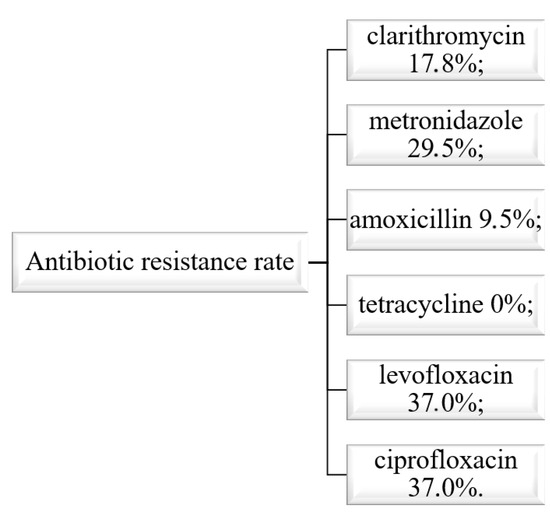
Figure 12.
Antibiotic resistance rate.
The distribution of resistance to metronidazole and fluoroquinolones was highly variable geographically. Multiple resistance to the three/four major antibiotics (amoxicillin, clarithromycin, metronidazole, tetracycline) plus quinolones was above 25% [39].
Macrolides are widely used in the treatment of other upper and lower respiratory tract infections. The study published by Know et al. [40], which included 46,160 subjects, tested resistance to clarithromycin. The results suggest that the rate of resistance to clarithromycin in Korea was over 16% and that exposure to macrolides may increase the likelihood of isolating clarithromycin-resistant H. pylori, which may affect the success of standard triple therapy [40].
The retrospective study, which included 3074 biopsy samples, published in 2016, suggests that over 36% were resistant to clarithromycin, over 77% to metronidazole, over 16% to levofloxacin, and 0.3% to amoxicillin, and no strains resistant to furazolidone or tetracycline were detected. Significant regional differences were also recorded. Multiple resistance (to two or more antibiotics) was detected in 36.3% of strains, and the predominant pattern was dual resistance to clarithromycin and metronidazole [41].
The systematic review published by TC. Hong et al. [42] suggest that the prevalence of primary resistance of H. pylori has increased for clarithromycin, metronidazole, and levofloxacin, while resistance to amoxicillin and tetracycline has remained stable between 1990 and 2022 [42]. Individualized treatment, guided by susceptibility testing, is recommended; the best treatment regimens should be selected. Mutations in genes encoding the target protein of antibiotics are significant risk factors for resistance. Iatrogenic errors in diagnosis and treatment prescription for eradication failure are other important risk factors. Low awareness and non-compliance with treatment contribute to increased resistance. Epidemiological surveillance of resistance and the adoption of new treatment strategies are necessary [43].
3.1. The Situation in Romania
The study published by C. Costache et al. [44] suggests that primary resistance was observed in northwestern and central Romania, at 16.7% for clarithromycin, 11.1% for fluoroquinolones, and 13.3% for metronidazole, while secondary resistance was more common, especially for clarithromycin (75.8%), and no strains resistant to amoxicillin, tetracycline, or rifampicin were identified. The results also showed that genotype A2147G was most commonly associated with resistance to clarithromycin [44]. Increased resistance to clarithromycin was also identified in northeastern Romania, according to a study conducted by E. L. Popovici et al. [45]; the eradication rate of H. pylori was observed in 79.7% of cases [45].
3.2. Future Directions
W.D. Chey and colleagues identified key gaps in knowledge regarding H. pylori infection management in North America (2024), highlighting the need for research priorities that facilitate gastric cancer prevention and treatment optimization. To this end, they published the “ACG Clinical Guideline: Treatment of Helicobacter pylori Infection” [2]. To address these gaps, the authors consider it crucial to invest in multicenter studies in North America that include the region’s population diversity, integrate bacterial susceptibility testing and pharmacogenomics (e.g., CYP2C19) into treatment guidelines, and implement national registries for monitoring antibiotic resistance and eradication efficacy on specific regimens. Advancing research in these directions would facilitate the identification of target groups for opportunistic testing, the personalization of therapy by choosing between PCAB- and IPP-based regimens, the optimization of dual PCAB+ amoxicillin therapy, and, ultimately, the improvement of eradication rates and, through the prevention of gastric cancer, health outcomes in North America [2].
In the context of H. pylori eradication, a history of macrolide use should be considered a risk factor for clarithromycin resistance. It is advisable to consider susceptibility testing before choosing therapy (especially in patients with recent exposure to macrolides) or to opt for alternative regimens that do not use clarithromycin (e.g., bismuth therapies or other non-clarithromycin combinations) to increase the eradication rate.
Substrate for responsible antibiotic practice: reduce the use of macrolides for unjustified purposes to limit the emergence of resistance.
The absence of resistance to tetracycline and furazolidone suggests that these antibiotics remain viable options, but their use may be influenced by therapeutic guidelines, availability, and safety profile. The considerable level of multidrug resistance (over 35%), particularly to the clarithromycin/metronidazole combination, highlights the need for a treatment strategy tailored to the region and susceptibility, reducing reliance on traditional empirical “triple” therapy [41].
The discovery of an effective vaccine against H. pylori could reduce resistance pressure globally [43].
It is well known that H. pylori infection disrupts the intestinal microbiota; in addition, eradication therapy alters the microbial composition. To optimize H. pylori treatment, an approach combining eradication with microbiota support (through appropriate probiotics), long-term monitoring of intestinal health, and personalization of therapies based on microbial profile is needed. Longitudinal research is imperative to clarify the relationship between microbial changes and gastric cancer risk and to develop protocols that minimize dysbiosis and maximize preventive formulations [46].
YK. Lai et al. also propose a multifaceted antibiotic-free system based on HKUST-1 (copper-organic framework) coated with a lipid layer of phosphatidic acid (PA), rhamnolipid (RHL), and cholesterol (CHOL), enclosed in chitosan (CS), and incorporated into a hydrogel with ascorbyl palmitate (AP): AP@CS@Lip@HKUST-1. Potential benefits identified include a non-antibiotic approach, reducing the risk of antibiotic resistance, and the fact that it targets multiple bases of infection persistence (biofilms, intracellular reservoirs, inflammation, and mucosal repair) and could potentially preserve the intestinal microbiota [47].
Recent studies exploring oxidative stress treatment and acid-inhibiting mechanisms, the impact of gastrointestinal flora, adjuvant probiotic therapy, and the role of neutrophil-activating protein, indicate promising future directions [25].
The key directions identified in the article published by L. Boyanova [13] are summarized in Figure 13.

Figure 13.
Key directions for reducing H. pylori antibiotic resistance.
3.3. Strengths and Limitations of the Study
This research provides a broader understanding of changes in research priorities and patterns than typical reviews, but it also has limitations. First, only the WoS database was used, omitting sources such as PubMed, Medline, or Google Scholar, which may lead to incomplete coverage of the literature. Second, it focused only on English-language articles and reviews, possibly excluding valuable works.
4. Materials and Methods
For this bibliometric analysis, we used the Web of Science Core Collection (WoS) database. This choice was made after a careful assessment of recent literature and the objectives of our study. Although using multiple databases could enhance coverage, recent studies show that such an approach introduces significant methodological difficulties. WoS was selected because it provides comprehensive bibliographic records with few missing abstracts, enabling mapping of keyword co-occurrence and thematic evolution. Using a single database eliminated the methodological complexities of integrating multiple sources, thus increasing the reliability and reproducibility of the analysis.
The following query was used: ALL: ‘H. pylori resistance to antibiotics’ (Topic) OR ‘bismuth quadruple therapy’ OR ‘clarithromycin resistance’ OR ‘eradication’ OR ‘eradication rate’ OR ‘eradication therapy’ OR ‘gastritis’ OR ‘h pylori’ OR ‘helicobacter pylori’ OR ‘helicobacter pylori eradication’ OR ‘helicobacter pylori infection’ OR ‘helicobacter-pylori’ OR ‘high-dose dual therapy’ OR ‘italic helicobacter pylori italic’ OR ‘quadruple therapy’. The Boolean operator OR was applied to broaden the search, including synonyms and related terms.
Initially, 160,162 documents were identified. To improve relevance and homogeneity for bibliometric analysis, two filters were applied:
First, only publications classified as “articles” in WoS were retained, excluding reviews and other publication types (proceedings, letters), to reduce potential methodological heterogeneity. Second, only articles in English were included, ensuring consistency and avoiding terminological distortions across languages—especially relevant for keyword co-occurrence and thematic clustering. Furthermore, including only English-language publications ensures more reliable application of automated keyword standardization and clustering techniques, facilitating more accurate identification of research trends and developments. After applying filters, the dataset was reduced to 39,879 articles (Figure 14).
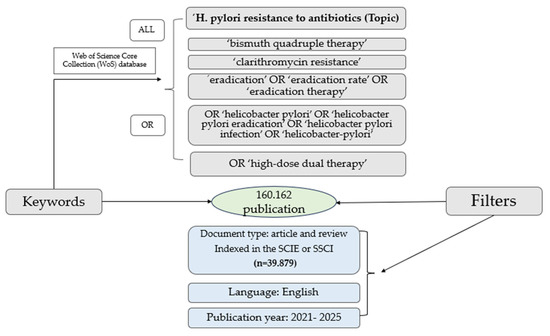
Figure 14.
Flow diagram of the study.
The bibliometric analysis used the VOSviewer software program ( version 1.6.20) to generate network visualizations (co-authorship, citations, keyword co-occurrence), highlighting collaboration models and thematic groups and Microsoft Excel for processing, organizing, and visualizing data, facilitating clearer interpretation.
5. Conclusions
This bibliometric analysis highlights researchers’ growing interest in studies on H. pylori antibiotic resistance, reflected in the increasing volume of publications in recent years. Over the past decade, published articles have made fundamental contributions, such as clinical guidelines and recommendations necessary for medical practice, while epidemiological studies and studies on the risk of gastric cancer add an important perspective on the global impact of the infection. At the same time, research focused on microbiology, resistance, and innovative technologies is a valuable complement to knowledge, being intended for in-depth and advanced research. This dynamic reflects an evolution in the field, oriented towards a complex understanding of resistance and the development of effective solutions for the management of H. pylori infection. A reassessment of treatment strategies for H. pylori is needed in the context of increasing resistance. Priority actions include resistance monitoring, judicious use of antibiotics, development of new or adapted regimens to susceptibility patterns, and exploration of alternative or complementary therapeutic approaches. Understanding the molecular mechanisms of resistance (mutations, efflux pumps, biofilm) is essential for identifying new targets and improving eradication strategies at the individual and public levels. Previous use of macrolide antibiotics and recent diagnosis of respiratory disease are independent risk factors for clarithromycin resistance in H. pylori. To control H. pylori antibiotic resistance and improve eradication rates, an integrated approach is essential: robust resistance surveillance, personalized treatment based on susceptibility, rational antibiotic use, patient education and medical practices, and accelerated vaccine development. Without these measures, resistance will continue to increase and the effectiveness of treatment regimens will diminish. Effective vaccination could be one of the most effective strategies for reducing antibiotic pressure worldwide.
Author Contributions
Conceptualization, S.D.M., R.N.S. and O.F.; methodology, S.D.M. and T.I.; software, C.H.; validation, S.D.M., R.N.S. and O.F.; formal analysis, S.D.M. and R.N.S.; investigation, S.D.M.; resources, S.D.M. and R.N.S.; data curation, S.D.M.; writing—original draft preparation, S.D.M., R.N.S., T.I. and C.H.; writing—review and editing, O.F.; visualization, S.D.M., R.N.S., T.I. and C.H.; supervision, O.F. All authors have read and agreed to the published version of the manuscript.
Funding
The APC was funded by the University of Oradea, Romania.
Institutional Review Board Statement
Not applicable.
Informed Consent Statement
Not applicable.
Data Availability Statement
No new data were created or analyzed in this study. Data sharing is not applicable to this article.
Acknowledgments
The Authors thank the University of Oradea for considering the logistic facilities they have used.
Conflicts of Interest
The authors declare no conflicts of interest.
References
- Kotilea, K.; Bontems, P.; Touati, E. Epidemiology, Diagnosis and Risk Factors of Helicobacter pylori Infection. Adv. Exp. Med. Biol. 2019, 1149, 17–33. [Google Scholar] [CrossRef]
- Chey, W.D.; Howden, C.W.; Moss, S.F.; Morgan, D.R.; Greer, K.B.; Grover, S.; Shah, S.C. ACG Clinical Guideline: Treatment of Helicobacter pylori Infection. Am. J. Gastroenterol. 2024, 119, 1730–1753. [Google Scholar] [CrossRef]
- Violeta Filip, P.; Cuciureanu, D.; Sorina Diaconu, L.; Maria Vladareanu, A.; Silvia Pop, C. MALT lymphoma: Epidemiology, clinical diagnosis and treatment. J. Med. Life 2018, 11, 187–193. [Google Scholar] [CrossRef] [PubMed]
- Ailloud, F.; Estibariz, I.; Suerbaum, S. Evolved to vary: Genome and epigenome variation in the human pathogen Helicobacter pylori. FEMS Microbiol. Rev. 2021, 45, fuaa042. [Google Scholar] [CrossRef] [PubMed]
- Aktas, D.; Bagirova, M.; Allahverdiyev, A.M.; Abamor, E.S.; Safarov, T.; Kocazeybek, B.S. Resuscitation of the Helicobacter pylori Coccoid Forms by Resuscitation Promoter Factor Obtained from Micrococcus Luteus. Curr. Microbiol. 2020, 77, 2093–2103. [Google Scholar] [CrossRef] [PubMed]
- Zhang, X.; He, Y.; Zhang, X.; Fu, B.; Song, Z.; Wang, L.; Fu, R.; Lu, X.; Xing, J.; Lv, J.; et al. Sustained exposure to Helicobacter pylori induces immune tolerance by desensitizing TLR6. Gastric Cancer 2024, 27, 324–342. [Google Scholar] [CrossRef]
- Cammarota, G.; Sanguinetti, M.; Gallo, A.; Posteraro, B. Review article: Biofilm formation by Helicobacter pylori as a target for eradication of resistant infection. Aliment. Pharmacol. Ther. 2012, 36, 222–230. [Google Scholar] [CrossRef]
- Reshetnyak, V.I.; Reshetnyak, T.M. Significance of dormant forms of Helicobacter pyloriin ulcerogenesis. World J. Gastroenterol. 2017, 23, 4867–4878. [Google Scholar] [CrossRef]
- Di Fermo, P.; Di Lodovico, S.; Di Campli, E.; D’arcangelo, S.; Diban, F.; D’ercole, S.; Di Giulio, M.; Cellini, L. Dormant States are Affected by Vitamin C. Int. J. Mol. Sci. 2023, 24, 5776. [Google Scholar] [CrossRef]
- Sarem, M.; Corti, R. Role of Helicobacter pylori coccoid forms in infection and recrudescence. Gastroenterol. Hepatol. 2016, 39, 28–35. [Google Scholar] [CrossRef]
- Zhao, X.; Zhong, J.; Wei, C.; Lin, C.-W.; Ding, T. Current Perspectives on Viable but Non-culturable State in Foodborne Pathogens. Front. Microbiol. 2017, 8, 580. [Google Scholar] [CrossRef] [PubMed]
- Boyanova, L.; Hadzhiyski, P.; Gergova, R.; Markovska, R. Evolution of Helicobacter pylori Resistance to Antibiotics: A Topic of Increasing Concern. Antibiotics 2023, 12, 332. [Google Scholar] [CrossRef] [PubMed]
- Boyanova, L.; Hadzhiyski, P.; Kandilarov, N.; Markovska, R.; Mitov, I. Multidrug resistance inHelicobacter pylori: Current state and future directions. Expert Rev. Clin. Pharmacol. 2019, 12, 909–915. [Google Scholar] [CrossRef] [PubMed]
- Iovanovici, D.C.; Dogaru, B.G.; Cseppento, C.D.N.; Purza, A.L.; Aur, C.; Mocuta, D.; Behl, T.; Bungau, S.G. Benefits of sacubitril/valsartan administration and physical training in cardiac rehabilitation: Current trends and bibliometric analysis of the years 2015–2024. Balneo PRM Res. J. 2024, 15, 683. [Google Scholar] [CrossRef]
- Malfertheiner, P.; Megraud, F.; Rokkas, T.; Gisbert, J.P.; Liou, J.-M.; Schulz, C.; Gasbarrini, A.; Hunt, R.H.; Leja, M.; O’Morain, C.; et al. Management of Helicobacter pylori infection: The Maastricht VI/Florence consensus report. Gut 2022, 71, 1724–1762. [Google Scholar] [CrossRef]
- Malfertheiner, P.; Camargo, M.C.; El-Omar, E.; Liou, J.-M.; Peek, R.; Schulz, C.; Smith, S.I.; Suerbaum, S. Helicobacter pylori infection. Nat. Rev. Dis. Prim. 2023, 9, 19. [Google Scholar] [CrossRef]
- Morgan, E.; Arnold, M.; Camargo, M.C.; Gini, A.; Kunzmann, A.T.; Matsuda, T.; Meheus, F.; Verhoeven, R.H.; Vignat, J.; Laversanne, M.; et al. The current and future incidence and mortality of gastric cancer in 185 countries, 2020–2040: A population-based modelling study. EClinicalMedicine 2022, 47, 101404. [Google Scholar] [CrossRef]
- Geng, T.; Yu, Z.-S.; Zhou, X.-X.; Liu, B.; Zhang, H.-H.; Li, Z.-Y. Antibiotic resistance of Helicobacter pylori isolated from children in Chongqing, China. Eur. J. Pediatr. 2022, 181, 2715–2722. [Google Scholar] [CrossRef]
- Wong, M.C.S.; Huang, J.; Chan, P.S.F.; Choi, P.; Lao, X.Q.; Chan, S.M.; Teoh, A.; Liang, P. Global Incidence and Mortality of Gastric Cancer, 1980–2018. JAMA Netw. Open 2021, 4, e2118457. [Google Scholar] [CrossRef]
- Chen, C.-C.; Liou, J.-M.; Lee, Y.-C.; Hong, T.-C.; El-Omar, E.M.; Wu, M.-S. The interplay between Helicobacter pylori and gastrointestinal microbiota. Gut Microbes 2021, 13, 1909459. [Google Scholar] [CrossRef]
- Yang, L.; Kartsonaki, C.; Yao, P.; de Martel, C.; Plummer, M.; Chapman, D.; Guo, Y.; Clark, S.; Walters, R.G.; Chen, Y.; et al. The relative and attributable risks of cardia and non-cardia gastric cancer associated with Helicobacter pylori infection in China: A case-cohort study. Lancet Public Health 2021, 6, e888–e896. [Google Scholar] [CrossRef]
- Chen, Y.-C.; Malfertheiner, P.; Yu, H.-T.; Kuo, C.-L.; Chang, Y.-Y.; Meng, F.-T.; Wu, Y.-X.; Hsiao, J.-L.; Chen, M.-J.; Lin, K.-P.; et al. Global Prevalence of Helicobacter pylori Infection and Incidence of Gastric Cancer Between 1980 and 2022. Gastroenterology 2024, 166, 605–619. [Google Scholar] [CrossRef]
- Chiang, T.-H.; Chang, W.-J.; Chen, S.L.-S.; Yen, A.M.-F.; Fann, J.C.-Y.; Chiu, S.Y.-H.; Chen, Y.-R.; Chuang, S.-L.; Shieh, C.-F.; Liu, C.-Y.; et al. Mass eradication of Helicobacter pylori to reduce gastric cancer incidence and mortality: A long-term cohort study on Matsu Islands. Gut 2021, 70, 243–250. [Google Scholar] [CrossRef]
- Zhang, L.; Zhang, L.; Deng, H.; Li, H.; Tang, W.; Guan, L.; Qiu, Y.; Donovan, M.J.; Chen, Z.; Tan, W. In vivo activation of pH-responsive oxidase-like graphitic nanozymes for selective killing of Helicobacter pylori. Nat. Commun. 2021, 12, 2002. [Google Scholar] [CrossRef]
- Yu, C.; Qiu, J.; Xiong, M.; Ou, C.; Zeng, M.; Song, H. Trends in Helicobacter pylori resistance research (2002–2022): A bibliometric analysis. Front. Med. 2022, 9, 1027534. [Google Scholar] [CrossRef]
- Wang, R.; Huang, S.; Gan, P.; Pan, X.; Wang, P.; Zhong, X.; Lü, M.; Zhou, X.; Tang, X. States and hotspots in Helicobacter pylori research from 2002 to 2021: A bibliometric analysis. Helicobacter 2023, 28, e12986. [Google Scholar] [CrossRef]
- Farina, S.; Fevola, G.; Adduci, A.; Maio, A.; Lontano, A.; Ricciardi, W.; Gualano, M.R.; Villani, L. Trends in antimicrobial resistance education research: A bibliometric analysis. One Heal. 2025, 21, 101120. [Google Scholar] [CrossRef] [PubMed]
- Nuñez-Aldaz, S.R.; Bonifaz-Díaz, D.R. Revision bibliografica: Prevalencia de la infección por helicobacter pylori drogo-resistente. MQRInvestigar 2024, 8, 3029–3047. [Google Scholar] [CrossRef]
- Yuan, C.; Yu, C.; Sun, Q.; Xiong, M.; Zhou, S.; Zeng, M.; Song, H. Research on antibiotic resistance in Helicobacter pylori: A bibliometric analysis of the past decade. Front. Microbiol. 2023, 14, 1208157. [Google Scholar] [CrossRef] [PubMed]
- Ouyang, Y.; Zhu, Z.; Huang, L.; Zeng, C.; Zhang, L.; Wu, W.K.; Lu, N.; Xie, C. Research Trends on Clinical Helicobacter pylori Eradication: A Bibliometric Analysis from 1983 to 2020. Helicobacter 2021, 26, e12835. [Google Scholar] [CrossRef]
- Fang, Y.; Jiang, S.; Zhou, X.; Zhou, W.; Jiang, X.; Chen, L.; Wang, M.; Chen, Y.; Li, L. Whole-genome sequencing analyses and antibiotic resistance situation of 48 Helicobacter pylori strains isolated in Zhejiang, China. Gut Pathog. 2024, 16, 62. [Google Scholar] [CrossRef] [PubMed]
- Li, M.; Gao, N.; Wang, S.; Guo, Y.; Liu, Z. Bibliometric analysis of Helicobacter pylori resistance—From 2002 to 2022. Helicobacter 2023, 28, e12983. [Google Scholar] [CrossRef] [PubMed]
- Hasanuzzaman, M.; Bang, C.S.; Gong, E.J. Antibiotic Resistance of Helicobacter pylori: Mechanisms and Clinical Implications. J. Korean Med. Sci. 2024, 39, e44. [Google Scholar] [CrossRef] [PubMed]
- Linz, B.; Balloux, F.; Moodley, Y.; Manica, A.; Liu, H.; Roumagnac, P.; Falush, D.; Stamer, C.; Prugnolle, F.; van der Merwe, S.W.; et al. An African origin for the intimate association between humans and Helicobacter pylori. Nature 2007, 445, 915–918. [Google Scholar] [CrossRef]
- Zhang, Y.; Wen, Y.; Xiao, Q.; Zheng, W.; Long, G.; Chen, B.; Shu, X.; Jiang, M. Mutations in the Antibiotic Target Genes Related to Clarithromycin, Metronidazole and Levofloxacin Resistance in Helicobacter pylori Strains from Children in China. Infect. Drug Resist. 2020, 13, 311–322. [Google Scholar] [CrossRef]
- Xu, G.; Shi, Y.; Zhang, X.; Yang, M.; Sun, Y.; Zhang, N.; Li, Z. Correlation Analysis of Pathways and Operons of Helicobacter pylori Resistance Genes Using Bibliometrics. Clin. Lab. 2019, 65, 673–683. [Google Scholar] [CrossRef]
- Jaiswal, N.; Kandpal, M.; Jha, H.C.; Kumar, A. Collective in-silico and in-vitro evaluation indicate natural phenolics as a potential therapeutic candidate targeting antimicrobial-resistant genes of Helicobacter pylori. Int. J. Biol. Macromol. 2025, 307, 142197. [Google Scholar] [CrossRef]
- Yu, Y.; Xue, J.; Lin, F.; Liu, D.; Zhang, W.; Ru, S.; Jiang, F. Global Primary Antibiotic Resistance Rate of Helicobacter pylori in Recent 10 years: A Systematic Review and Meta-Analysis. Helicobacter 2024, 29, e13103. [Google Scholar] [CrossRef]
- Lee, J.H.; Ahn, J.Y.; Choi, K.D.; Jung, H.; Kim, J.M.; Baik, G.H.; Kim, B.; Park, J.C.; Jung, H.; Cho, S.J.; et al. Nationwide antibiotic resistance mapping of Helicobacter pylori in Korea: A prospective multicenter study. Helicobacter 2019, 24, e12592. [Google Scholar] [CrossRef]
- Kwon, Y.M.; Kim, S.J.; Lee, J.G.; Lee, S.P. Effects of prior antibiotic use on clarithromycin resistance in Helicobacter pylori. Helicobacter 2023, 28, e12974. [Google Scholar] [CrossRef]
- Xu, W.; Yang, B.; Lin, L.; Lin, Q.; Wang, H.; Yang, L.; Li, Z.; Lamm, S.; Chen, Y.; Yang, N.; et al. Antibiotic resistance of Helicobacter pylori in Chinese children: A multicenter study from 2016 to 2023. Helicobacter 2024, 29, e13038. [Google Scholar] [CrossRef]
- Hong, T.-C.; El-Omar, E.M.; Kuo, Y.-T.; Wu, J.-Y.; Chen, M.-J.; Chen, C.-C.; Fang, Y.-J.; Leow, A.H.R.; Lu, H.; Lin, J.-T.; et al. Primary antibiotic resistance of Helicobacter pylori in the Asia-Pacific region between 1990 and 2022: An updated systematic review and meta-analysis. Lancet Gastroenterol. Hepatol. 2024, 9, 56–67. [Google Scholar] [CrossRef]
- Mladenova, I. Epidemiology of Helicobacter pylori Resistance to Antibiotics (A Narrative Review). Antibiotics 2023, 12, 1184. [Google Scholar] [CrossRef]
- Costache, C.; Colosi, H.A.; Grad, S.; Paștiu, A.I.; Militaru, M.; Hădărean, A.P.; Țoc, D.A.; Neculicioiu, V.S.; Baciu, A.M.; Opris, R.V.; et al. Antibiotic Resistance in Helicobacter pylori Isolates from Northwestern and Central Romania Detected by Culture-Based and PCR-Based Methods. Antibiotics 2023, 12, 1672. [Google Scholar] [CrossRef] [PubMed]
- Popovici, E.L.; Cojocariu, L.H.; Girleanu, I.; Dimache, M.; Moscalu, A.T. Eradication of Helicobacter Pylori. The Response to Triple Standard Therapy in a Center of North-Eastern Romania. Farmacia 2021, 69, 756–762. [Google Scholar] [CrossRef]
- Albush, A.; Yassine, F.; Abbas, H.; Hanna, A.; Saba, E.; Bilen, M. The impact of Helicobacter pylori infection and eradication therapies on gut microbiota: A systematic review of microbial dysbiosis and its implications in gastric carcinogenesis. Front. Cell. Infect. Microbiol. 2025, 15, 1592977. [Google Scholar] [CrossRef]
- Lai, Y.; Zhang, T.; Yin, X.; Zhu, C.; Du, Y.; Li, Z.; Gao, J. An antibiotic-free platform for eliminating persistent Helicobacter pylori infection without disrupting gut microbiota. Acta Pharm. Sin. B 2024, 14, 3184–3204. [Google Scholar] [CrossRef] [PubMed]
Disclaimer/Publisher’s Note: The statements, opinions and data contained in all publications are solely those of the individual author(s) and contributor(s) and not of MDPI and/or the editor(s). MDPI and/or the editor(s) disclaim responsibility for any injury to people or property resulting from any ideas, methods, instructions or products referred to in the content. |
© 2025 by the authors. Licensee MDPI, Basel, Switzerland. This article is an open access article distributed under the terms and conditions of the Creative Commons Attribution (CC BY) license (https://creativecommons.org/licenses/by/4.0/).